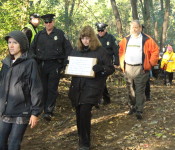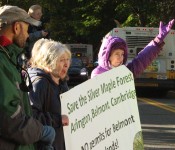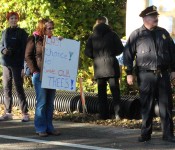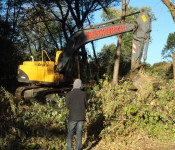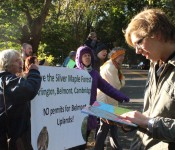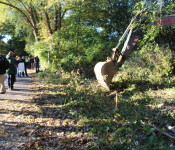Photo: The entry to the Belmont Uplands site in October.
As the town clarifies what the building permit issued this past Friday, March 6 to A.P. Cambridge Partners II – the developer of the proposed $70 million, 299-unit apartment complex at Belmont Uplands – will allow the development team to do, opponents to the long-delayed project have begun to speak out on the effect of the project will have on Belmont and surrounding communities.
“The issuance of a building permit to executives from Prudential Real Estate Insurance and developer Brian O’Neill appears to confirm that neither the town of Belmont nor the [Commonwealth] of Massachusetts consider it their duty to protect the public and the earth from pollution and flooding … ,” said Anne-Marie Lambert of Chilton Street, who has been a strong critic of the proposed complex being built amidst the Silver Maple Forest in the Alewife Reservation.
After two decades of plans, proposals (that included a commercial research and development building in the early 2000s), lawsuits and delays, Belmont’s Director of Community Development Glenn Clancy as town engineer issued the first of three permits allowing the Philadelphia-based O’Neill Properties Group to construct a five-building complex situated on 15 acres on the Cambridge line on Acorn Park Drive.
“The permit is the approval for foundations for each of the five buildings,” said Clancy Monday, March 9.
Clancy said the development team has acquired the necessary paperwork to being utility work at the site that is a stone’s throw from Route 2 and Arlington.
The actual building permit to do the remaining work that includes the framing and actual building is pending final sign-off from the Fire Prevention Office, said Clancy.
“A final building permit to do all work on the foundation is the only outstanding approval I am aware of,” he told the Belmontonian.
The town has been handcuffed in imposing local zoning bylaws on the proposed development as O’Neill is building the complex under the state’s Chapter 40B law.
Enacted in 1969, the law allows a developer to bypass local restrictions if the municipality’s housing stock is less than 10 percent is deemed affordable for moderate-income residents and when the builder sets aside a specific percentage – at Belmont Uplands it will be 60 units – for buyers with income less than the 80 percent of the median in the region.
For those who have kept a constant battle to prevent the construction of the development, the permit comes after six months of increasing evidence – the clearing of the site of trees and vegetation beginning in October and a recent request to allow the placement of construction parking – O’Neill Properties was preparing to begin actual building.
For Idith Haber of Oliver Road who is president of the Coalition to Preserve the Belmont Uplands, the town’s issuing O’Neill a building permit continues the lack of support groups that have been attempting to thwart the project, which included the Board of Selectmen withdrawing a lawsuit backed by the town’s Conservation Commission.
“The Coalition believes that issuing the building permit similarly inappropriate,” said Haber.
Both Haber and Lambert have long contended the site can not sustain a major development as it will impact local neighborhoods – in Belmont around Little Pond – with increased flooding and to the public health due to the potential of higher-than-expected stormwater activity.
“[It] appears to confirm that neither … Belmont nor the (Commonwealth) of Massachusetts consider it their duty to protect the public and the earth from pollution and flooding which will result from the undisputed 150,000 gallons of storm water runoff this project will generate,” Lambert said.
In 2014, Lambert presented data showing the amount of storm water at the site used by O’Neill to win approval by the state to move forward with the permitting process underestimates the storm water levels by a large percentage since the developer uses data published in 1961 instead of rainfall statistics from 2011 due to the impact of global warming.
With this new data, O’Neill would be in violation of the town’s Storm Water Bylaw passed by Town Meeting last year.
“It is shameful that [the developer] claims to have sensitivity to environmental issues yet invests in a project which blatantly ignores current climate change reality,” stated Lambert, adding that “ensuring enforcement of Belmont’s stormwater bylaw regulations throughout the town is also critical.”
While the town has issued the permit, there remains pending litigation filed to enforce Belmont’s stormwater bylaw and the Massachusetts Clean Water Act. Clancy said the court did “not explicitly” say the town could not issue the go-ahead.
“The applicant proceeds at their own risk,” he said.
Despite the town’s action, Haber has received words of encouragement to continue the fight.
“We continue to receive a lot of moral and financial support from Belmont, Cambridge, and Arlington residents,” Haber said.



